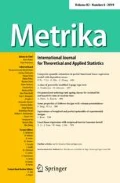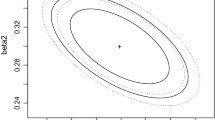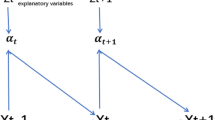Abstract
In this article, we consider the parameter estimation of regression model with pth-order autoregressive (AR(p)) error term. We use the maximum Lq-likelihood (MLq) estimation method proposed by Ferrari and Yang (Ann Stat 38(2):753–783, 2010), as a robust alternative to the classical maximum likelihood (ML) estimation method to handle the outliers in the data. After exploring the MLq estimators for the parameters of interest, we provide some asymptotic properties of the resulting MLq estimators. We give a simulation study and three real data examples to illustrate the performance of the proposed estimators over the ML estimators and observe that the MLq estimators have superiority over the ML estimators when some outliers are present in the data.












Similar content being viewed by others
References
Alpuim T, El-Shaarawi A (2008) On the efficiency of regression analysis with AR(p) errors. J Appl Stat 35(7):717–737
Ansley CF (1979) An algorithm for the exact likelihood of a mixed autoregressive-moving average process. Biometrika 66(1):59–65
Beach CM, Mackinnon JG (1978) A maximum likelihood procedure for regression with autocorrelated errors. Econom J Econom Soc 46(1):51–58
Cavalieri J (2002) O método de máxima Lq-verossimilhança em modelos com erros de medição. Doctoral thesis, Federal University of São Carlos, Department of Statistics. Retrieved from https://repositorio.ufscar.br/bitstream/handle/ufscar/4554/4180.pdf?sequence=1
Cochrane D, Orcutt GH (1949) Application of least square to relationship containing autocorrelated error terms. J Am Stat Assoc 44(245):32–61
Dogru FZ, Bulut YM, Arslan O (2018) Doubly reweighted estimators for the parameters of the multivariate t-distribution. Commun Stat Theory Methods 47(19):4751–4771
Ferrari D, Paterlini S (2009) The maximum Lq-likelihood method: an application to extreme quantile estimation in finance. Methodol Comput Appl Probab 11(1):3–19
Ferrari D, Paterlini S (2010) Efficient and robust estimation for financial returns: an approach based on q-entropy. Available at SSRN: http://ssrn.com/abstract=1906819 or http://dx.doi.org/10.2139/ssrn.1906819
Ferrari D, Yang Y (2007) Estimation of tail probability via the maximum Lq-likelihood method. Technical report 659, School of statistics, University of Minnesota
Ferrari D, Yang Y (2010) Maximum Lq-likelihood estimation. Ann Stat 38(2):753–783
Hampel FR, Ronchetti EM, Rousseeuw PJ, Stahel WA (1986) Robust statistics. The approach based on influence functions. Wiley, New York
Havrda J, Charvát F (1967) Quantification method of classification processes: concept of structural entropy. Kibernetika 3:30–35
Huang C, Lin J, Ren YY (2013) Testing for the shape parameter of generalized extreme value distribution based on the Lq-likelihood ratio statistic. Metrika 76(5):641–671
Huber PJ, Ronchetti EM (2009) Robust statistics. Wiley, New Jersey
Maronna RA, Martin RD, Yohai VJ (2006) Robust statistics: theory and methods. Wiley, Chichester
Ozdemir S, Güney Y, Tuaç Y, Arslan O (2019) Maximum Lq-likelihood estimation for the parameters of Marshall-Olkin extended burr XII distribution. Commun Fac Sci Univ Ank Ser A1 Math Stat 68(1):17–34
Qin Y, Priebe EC (2013) Maximum Lq-likelihood estimation via the expectation maximization algorithm: a robust estimation of mixture models. J Am Stat Assoc 108(503):914–928
Qin Y, Priebe EC (2017) Robust hypothesis testing via Lq-likelihood. Stat Sin 27:1793–1813
R Core Team (2017) R: A language and environment for statistical computing. R Foundation for Statistical Computing, Vienna, Austria. URL http://www.R-project.org
Ronchetti E (1985) Robust model selection in regression. Stat Prob Lett 3:21–23
Rousseeuw PJ, Leroy AM (1987) Robust regression and outlier detection. Wiley Series. Wiley, New York
Tsallis C (1988) Possible generalization of Boltzmann–Gibbs statistics. J Stat Phys 52:479–487
Tuaç Y, Güney Y, Senoglu B, Arslan O (2018) Robust parameter estimation of regression model with AR(p) error terms. Commun Stat Simul Comput 47(8):2343–2359
Tuaç Y, Güney Y, Arslan O (2020) Parameter estimation of regression model with AR (p) error terms based on skew distributions with EM algorithm. Soft Comput 24(5):3309–3330
Acknowledgements
The authors thank the anonymous reviewers for their careful reading and suggestions of this paper. Their comments and suggestions remarkably improved our paper.
Author information
Authors and Affiliations
Corresponding author
Ethics declarations
Conflict of interest
On behalf of all authors, the corresponding author states that there is no conflict of interest.
Additional information
Publisher's Note
Springer Nature remains neutral with regard to jurisdictional claims in published maps and institutional affiliations.
Appendices
Appendix A
Let \( \underline{\theta } = \left( { \beta_{1} , \beta_{2} , \ldots ,\beta_{M} ,\;\phi_{1} ,\phi_{2} , \ldots ,\phi_{p} ,\sigma^{2} } \right). \) The elements of \( U\left( {a_{t} ;\underline{\theta } } \right) \) are
where \( t = p + 1, \ldots ,N. \)
The second partial derivatives are
where \( t = p + 1, \ldots ,N, j,k = 1,2, \ldots ,M \) and \( r,s = 1,2, \ldots ,p. \)
Appendix B
The elements of \( U^{*} \left( {a_{t} ;\underline{\theta } ,q} \right) \) are
where
The second partial derivatives of conditional Lq-likelihood function can be obtained by substituting the derivatives given in “Appendix A” in Eq. (25).
Rights and permissions
About this article
Cite this article
Güney, Y., Tuaç, Y., Özdemir, Ş. et al. Conditional maximum Lq-likelihood estimation for regression model with autoregressive error terms. Metrika 84, 47–74 (2021). https://doi.org/10.1007/s00184-020-00774-2
Received:
Published:
Issue Date:
DOI: https://doi.org/10.1007/s00184-020-00774-2




